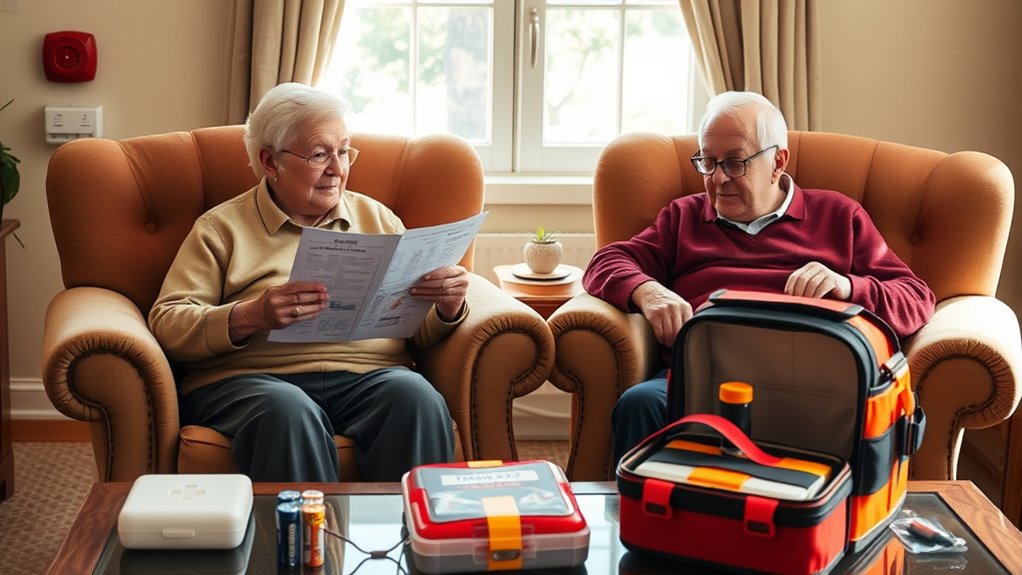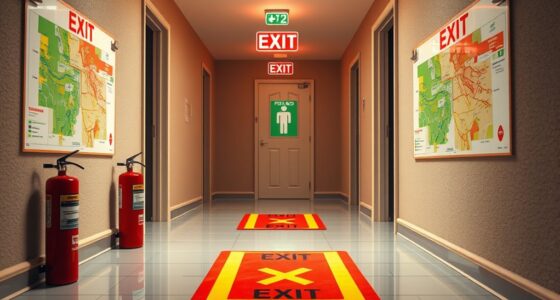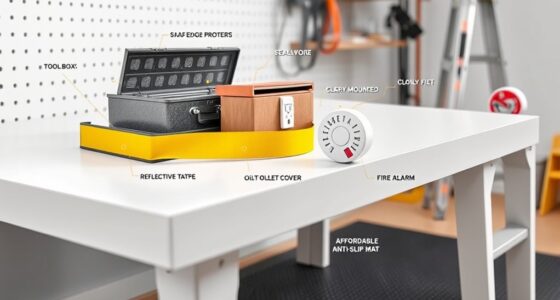To prepare for emergencies, you should learn your community’s plans and evacuation routes, stock essential supplies like medications, food, and water, and develop a detailed family emergency plan. Stay informed through local alerts and maintain regular communication with trusted contacts. Practice drills and organize important documents for quick access. Being proactive helps you stay safe and calm during a disaster. Discover more tips to help you feel confident in any crisis by exploring further details.
Key Takeaways
- Develop and regularly practice a personalized emergency plan, including communication, evacuation, and support networks.
- Stock essential supplies, medications, and assistive devices, ensuring accessibility and preparedness for at least 7-30 days.
- Register for local alert systems and community assistance programs to stay informed and receive support during crises.
- Keep important documents and medical information organized and stored securely, with digital backups if possible.
- Maintain clear communication strategies with family, neighbors, and emergency services for quick response and assistance.
How to Identify Risks and Learn Community Plans
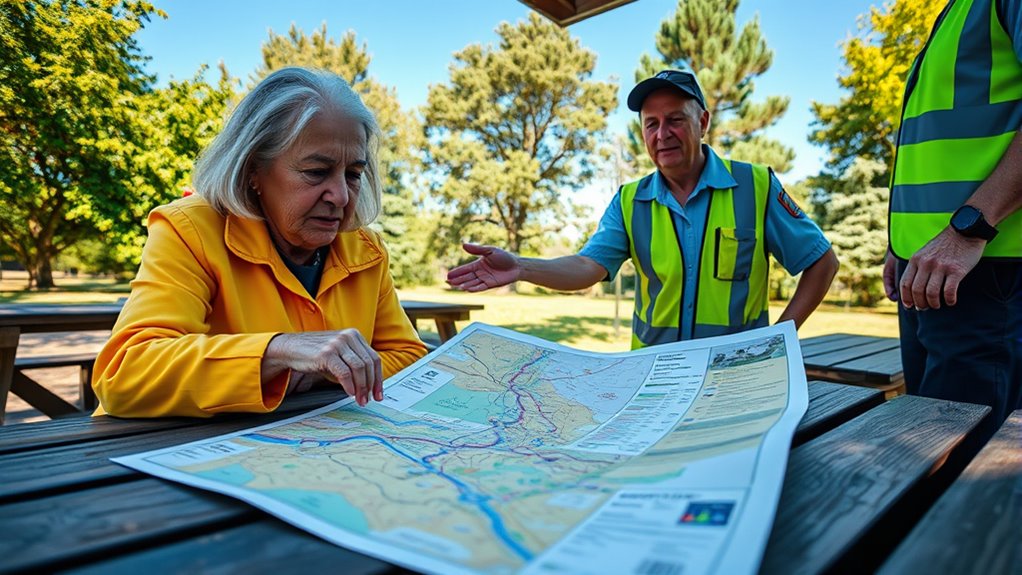
Understanding the risks in your community is the first step toward effective emergency preparedness. Make sure you review local emergency response plans and evacuation routes, which are often available through community websites or local government offices. Celebrating the importance of community support can motivate you to participate actively in local safety initiatives. Keep important documents, like your health records and emergency contacts, in a safe, accessible place. Sign up for community alert systems such as CodeRED, NIXLE, or local notification apps so you receive real-time warnings about disasters. Attend preparedness meetings or drills to see how local agencies respond and learn how you can help. Additionally, identify designated shelter locations and familiarize yourself with the procedures your community recommends during various emergencies. Recognizing the role of attention in creative practice can help you stay focused and calm during stressful situations, enabling better decision-making. Developing emergency communication tools can also enhance your ability to stay connected with loved ones and authorities during crises. Staying informed about community resources can further support your readiness and recovery efforts.
Essential Emergency Supplies for Seniors
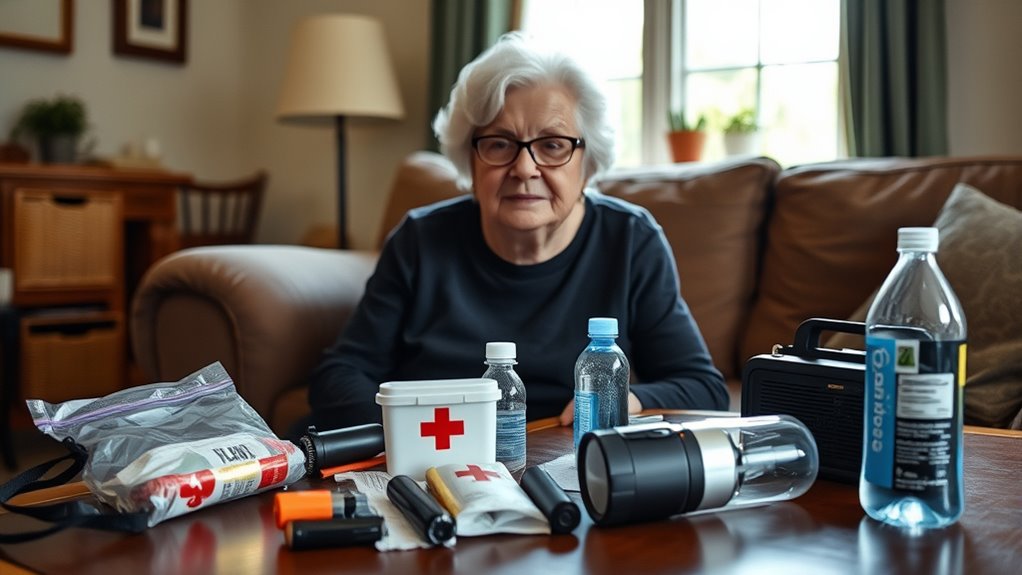
Having the right emergency supplies is vital for your safety. You should stock up on essential medications, assistive devices, and non-perishable foods that meet your dietary needs. It is also important to be aware of symptoms of breast cancer so you can seek medical attention promptly if needed. Being familiar with textile art techniques can inspire creative ways to prepare personalized emergency gear, such as custom bags or covers. Keeping important documents organized and accessible to guarantee quick access during an emergency is crucial. Additionally, understanding the benefits of airless paint sprayers can be helpful for home maintenance and safety during renovations or repairs. Incorporating tactical gear into your emergency plan can enhance your preparedness and safety in various situations. Utilizing smart devices like smart toilets with automated features can also improve hygiene and comfort during extended emergencies.
Must-Have Medical Supplies
To guarantee you’re prepared for emergencies, it’s crucial to have a well-stocked supply of medical essentials tailored to your needs. Start with a 30-day supply of prescription medications, including backup power sources if necessary.
Next, ensure you have key monitoring devices such as:
- Blood glucose meters
- Blood pressure monitors
- Oxygen tanks or concentrators (if applicable)
- Assistive devices like hearing aids, glasses, or mobility aids, with batteries or chargers
Keep a detailed list of all medications, dosages, and doctors in an accessible location. Additionally, include important medical information like allergies, chronic conditions, and emergency contacts. AI security advancements can also assist in managing your health data and alerts effectively during critical times, providing an additional layer of safety. Ensuring your medical records are up-to-date and easily accessible is vital for quick response during emergencies. Maintaining a comprehensive emergency kit with these supplies is essential for preparedness, especially considering how medical asset management can improve your ability to respond effectively.
Emergency Food & Water
Are you prepared to sustain yourself during an emergency? It’s essential to have at least a 7-day supply of non-perishable food and bottled water.
Aim for one gallon of water per person each day to stay hydrated. Stock easy-to-prepare or ready-to-eat meals like canned soups, energy bars, and dried fruits that require minimal cooking or water.
Store your water in food-grade containers and replace them every 6 to 12 months to keep supplies fresh and safe.
If you have dietary restrictions or health conditions, include specialized foods or supplements to meet your nutritional needs. Homemade fruit juices can be a nutritious addition to your emergency supplies, providing vitamins and hydration when fresh produce may not be available.
Keeping a manual can opener and utensils nearby ensures you can easily access and prepare your food during an emergency. Choosing compact and portable emergency supplies can make storage and transportation easier during crises.
Being prepared guarantees your safety and well-being during emergencies.
Emergency preparedness essentials provide vital knowledge and skills that can help you better respond during crises.
Important Documents Backup
During emergencies, quick access to your essential documents can make a critical difference. You should keep both digital and physical copies of important papers in a secure, easily accessible location. To stay prepared, consider:
- Storing copies in a fireproof box at home and online via a secure cloud service.
- Including a list of medications, dosages, and healthcare provider contact info.
- Adding recent photos and details of medical devices or assistive equipment.
- Regularly reviewing and updating documents to guarantee all information remains current.
- Understanding how automation technology can support emergency response efforts and ensure your information is readily available.
- Being aware of retail hours to plan timely visits for document updates or supplies.
- Utilizing secure storage solutions to protect sensitive information from cyber threats and physical damage.
Implementing necessary cookies can help monitor your preferences for storing and sharing this information securely. Having multiple copies in different safe places reduces the risk of losing crucial information. Incorporating self watering plant pots as part of your emergency preparedness can help maintain indoor greenery with minimal effort when access to regular care is limited. Keeping these documents organized and current ensures you can get quick assistance when seconds count during an emergency.
Developing a Personal and Family Emergency Plan
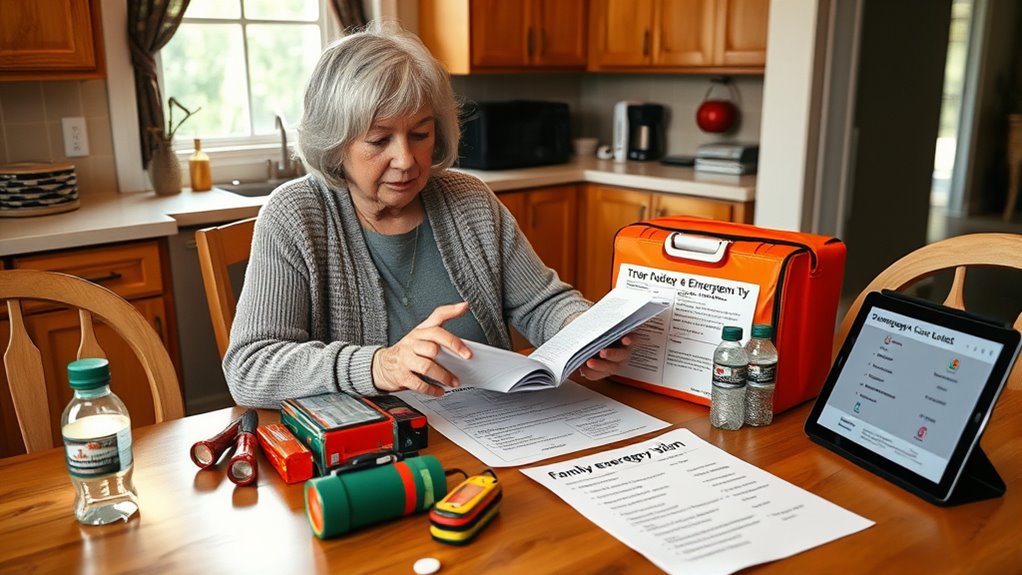
Developing a personal and family emergency plan is essential to guarantee everyone knows what to do when disaster strikes. Start by creating clear evacuation routes, designated meeting points, and communication methods with your family and caregivers. Consider including specific instructions for different types of emergencies, such as medical emergencies, natural disasters, or power outages, to ensure preparedness for various scenarios.
Make sure to identify and document each family member’s medical, physical, and cognitive needs, including medications and assistive devices. Compile a list of emergency contacts such as local emergency services, healthcare providers, and support networks. Understanding family dynamics can influence how effectively a plan is implemented and followed during crises, so understanding and accommodating family relationships is crucial.
Identify and record each family member’s medical, physical, and cognitive needs, along with emergency contacts.
Practice the plan regularly so everyone understands their roles and procedures. Keep emergency supplies, important documents, and medications organized and accessible to all family members. Regular drills help ensure preparedness and reduce confusion during actual emergencies. A well-crafted plan provides confidence and safety for your entire family in times of crisis.
Staying Informed and Communicating During Disasters
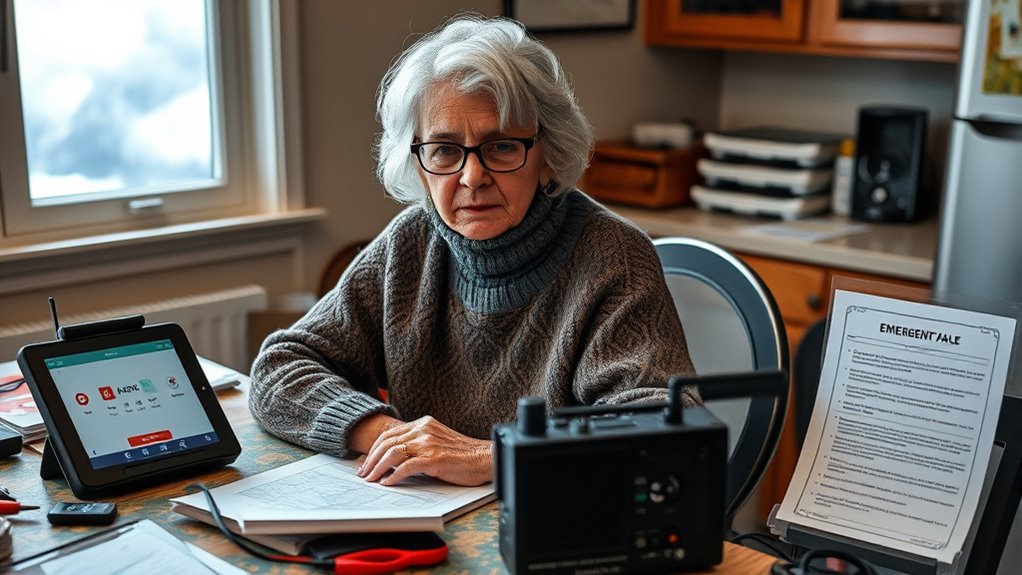
To stay informed during a disaster, you should sign up for local emergency alerts and keep a portable radio handy.
Make certain you have a clear communication plan with family, friends, and neighbors, including emergency contacts and check-in methods.
Using multiple communication tools guarantees you can stay connected, even if power or internet go out.
Sign Up for Alerts
Are you prepared to receive important updates when emergencies happen? Signing up for local alert systems keeps you informed in real time. To stay connected, consider these steps:
- Register with SMS alerts or phone notifications to get instant updates.
- Enroll in community registries that offer assistance for seniors and those with disabilities.
- Use multiple communication methods—texts, emails, or social media—to ensure you’re reached if one channel fails.
- Keep a current list of emergency contacts and support networks, and make sure they know your preferences.
Regularly review and update your alert settings and contact information. Staying proactive guarantees you’ll receive timely information and support during any disaster.
Maintain Emergency Contacts
Keeping your emergency contacts current is essential for effective communication during disasters. Make sure your list includes family, friends, neighbors, and local emergency services, and update it regularly.
Register with local alert systems and opt-in for notifications through SMS, email, or phone calls so you receive timely updates.
Share your specific needs and medical information with trusted contacts, guaranteeing they know how to assist you if needed.
Establish a clear communication plan that outlines how and when to contact each person, including backup methods if phone lines are down.
Regularly review and practice this plan, so everyone knows their role during an emergency.
Staying organized and prepared helps ensure help arrives quickly when you need it most.
Use Multiple Communication Methods
Using multiple communication methods guarantees you stay informed and can quickly share your needs during emergencies. To do this effectively:
- Register with local emergency alert systems and community notifications to receive automated alerts across various channels.
- Keep a list of emergency contacts in different formats—written, digital, or printed—so you’re always connected, even if one method fails.
- Practice your communication plan regularly with family, friends, and caregivers to ensure everyone knows how to reach you quickly.
- Use assistive technology like loud alarms, captioned alerts, or visual notifications to stay informed if you have hearing or vision impairments.
Responding Effectively When Disaster Strikes
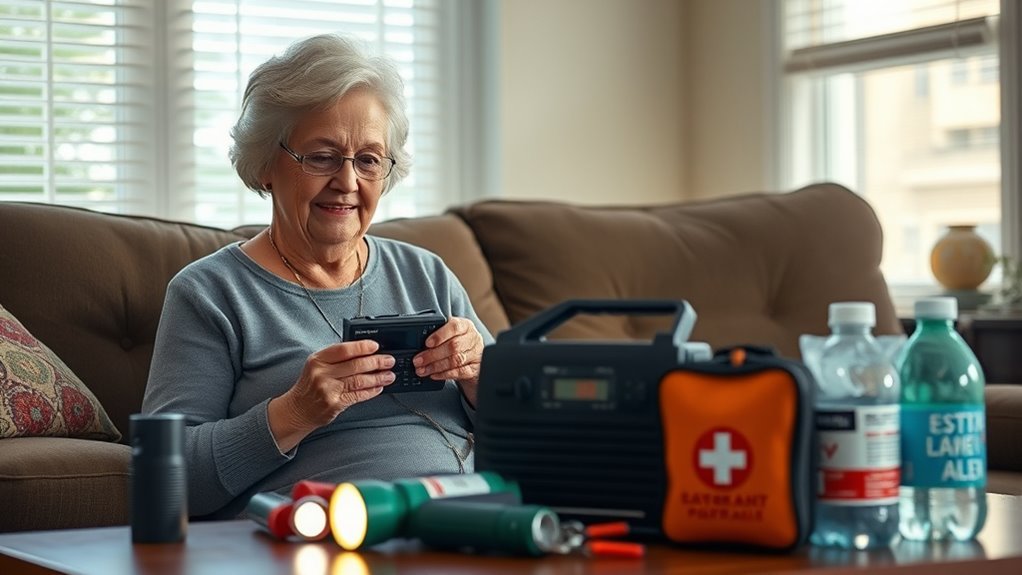
When disaster strikes, staying calm and quickly evaluating the situation is crucial to responding effectively. Take a moment to determine if you need to evacuate or shelter in place. Follow your emergency plan and listen carefully for official instructions through alerts or broadcasts.
Stay calm, assess the situation, and follow your emergency plan for effective disaster response.
Communicate your needs clearly to loved ones, neighbors, or emergency responders, especially if you require assistance. If the power goes out, use backup power sources or battery-operated devices to stay informed.
Prioritize safety by avoiding hazards like downed power lines or structural damage. If you’re injured or in immediate danger, seek help promptly.
Remaining composed and focused helps you make quick, safe decisions, ensuring your well-being during a disaster.
Safely Returning Home and Recovery Steps
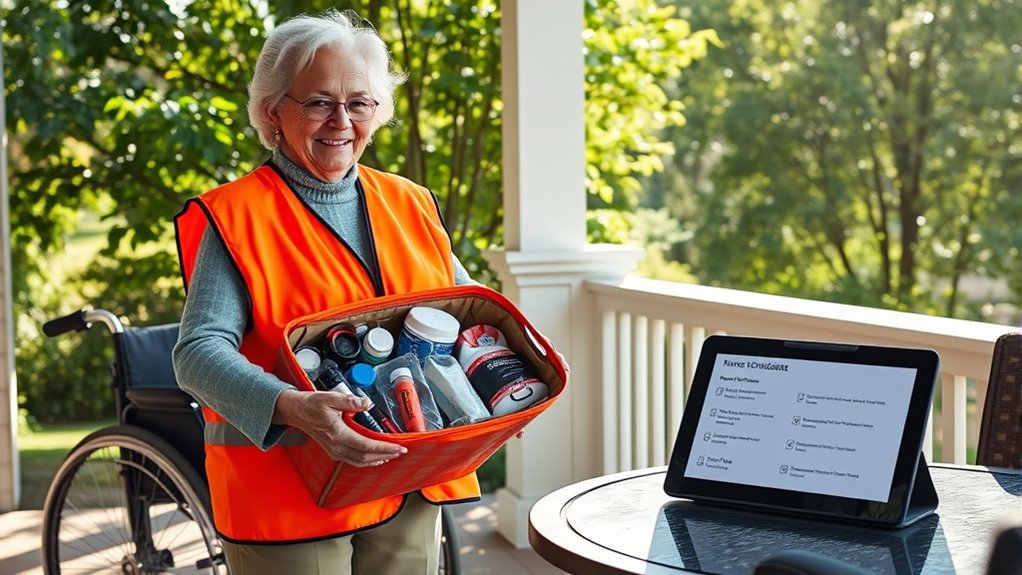
Before returning home after a disaster, it’s essential to wait for official confirmation that it’s safe to do so. Once you receive the all-clear, follow these recovery steps:
- Document any property damage with photos and notes to support insurance claims and repairs.
- Carefully and safely remove debris, adhering to local guidelines to prevent injuries.
- Check your home’s structural stability before entering, ensuring it’s safe to move inside.
- Collaborate with trusted agencies and community organizations to access recovery resources and support.
Additionally, check on neighbors and loved ones, especially those with special needs. This ensures everyone’s well-being and helps coordinate community recovery efforts effectively. Always prioritize safety and official guidance during this critical phase.
Resources and Support for Emergency Preparedness
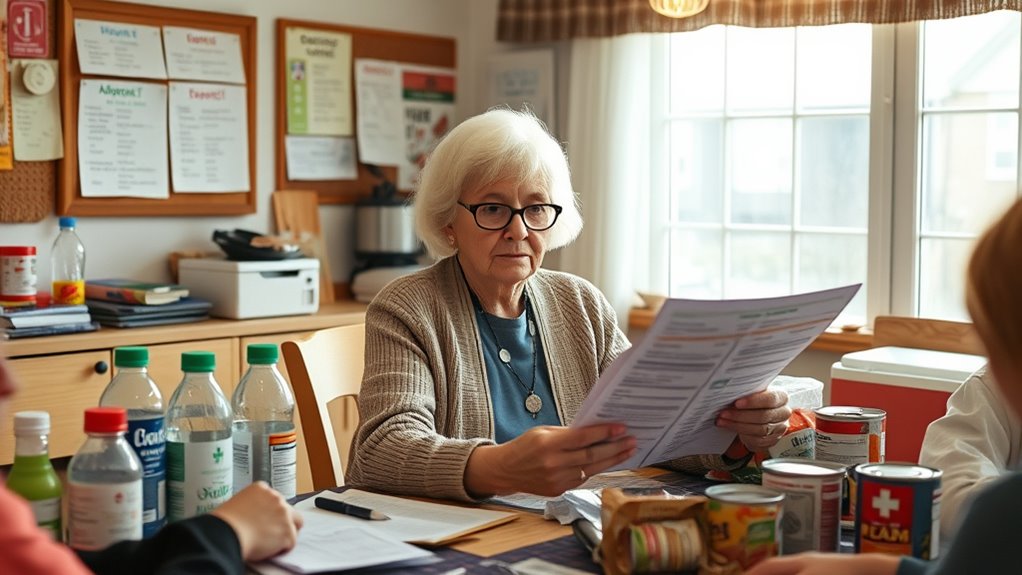
Have you explored the many resources available to help seniors prepare for emergencies? Many organizations, like FEMA and the American Red Cross, offer free guides and checklists designed specifically for seniors to enhance safety.
Local community centers and senior groups often hold training sessions and workshops on disaster response and safety tips tailored for older adults.
Financial assistance programs can help you buy essential emergency supplies, medications, and assistive devices before disaster strikes.
You can also register with special alert systems, such as the National Emergency Alert System (EAS), customized for those with medical or mobility needs, ensuring timely notifications.
Additionally, online resources and hotlines are available to provide personalized advice, help locate nearby shelters, and connect you with support networks during emergencies.
Frequently Asked Questions
What Are the 10 Essential Survival Kit Items?
You need to gather the ten essential survival kit items to stay prepared. Pack enough non-perishable food and water for at least three days, with one gallon per person daily.
Include a flashlight with extra batteries, a first aid kit, and necessary medications.
Store important documents waterproofed, and add a multi-tool, emergency blanket, whistle, hearing aids, glasses, and mobility aids.
These items guarantee you’re ready for any emergency situation.
What Are the 5 Steps of Emergency Preparedness?
Think of emergency preparedness as your own safety blueprint, like the map guiding a hero through a challenge. First, assess risks specific to your area. Then, create a detailed plan covering communication, evacuation, and support.
Next, gather supplies for at least 30 days. Stay informed through alerts, and regularly practice your plan to build confidence. This proactive approach keeps you ready and resilient, no matter what comes your way.
How to Get a Free Emergency Kit?
You can find free emergency kits by checking with local health departments, senior centers, and organizations like the Red Cross. Many community programs and disaster preparedness events offer these kits at no cost.
Sign up for community alert systems or newsletters, which often share info about free supplies.
Also, look for online platforms or medical supply stores that sometimes distribute free kits, especially during awareness campaigns like National Preparedness Month.
What Is One Consideration for Older Adults When Dealing With an Emergency?
Imagine you’re steering a maze with a flashlight; now, picture an older adult facing an emergency. One key consideration is ensuring they’ve accessible evacuation plans tailored to their mobility and sensory needs.
You should also include support networks and check-in procedures, so they don’t feel lost or isolated. By addressing these factors, you help them stay safe and confident during stressful situations, just like guiding a light through the dark.
Conclusion
Preparing for emergencies keeps you safe and confident. Did you know that seniors are 2.5 times more likely to experience severe injury during disasters? By identifying risks, building supplies, and staying informed, you can reduce that risk. Having a plan and knowing what to do can make all the difference. Stay proactive, stay prepared, and guarantee you’re ready to handle any emergency with confidence and resilience.
